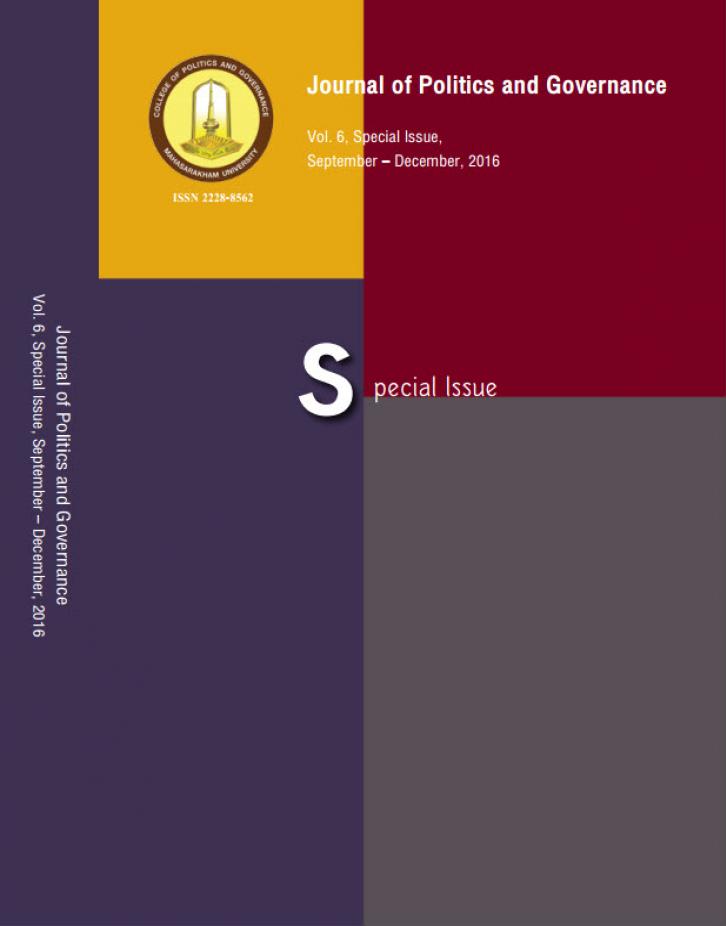The Politics of Municipal Merger in the Philippines
Main Article Content
Abstract
Contemporary municipal merger is an extraordinary case in the Philippines. The two rare cases of merger are explained using the Theory of Consolidation, but is found inadequate in explaining consolidation in the Philippines. Using an institutional choice framework, the following propositions were raised and substantiated: resident-voters will likely support merger if local elected leaders are united, and if there is no strong opposition from the community; local councils will likely support merger if their respective mayors with same party affiliation support merger, and if they see it as opportunity to stay in power, and mayors will likely support merger if they see it as opportunity to stay in power, and if they belong to the same party as the congressman, the reform agent. Interview with 58 key respondents is the primary method employed, complemented by the use of existing statistics, government records and other secondary materials.
Article Details

This work is licensed under a Creative Commons Attribution-NonCommercial-NoDerivatives 4.0 International License.
References
Butzer, M. & Marquis, L. (2002). Public opinion formation in Swiss federal referendums. In D. Farrell & R. Schmitt-Beck (Eds.), Do political campaigns matter? Campaign effects in elections and referendums. London: Routledge.
Carr, J. & Feoick, R. (2001). State annexation 'constraints' and the frequency of municipal annexation. Political Research Quarterly, 54 (2), 459-70. doi: 10.1177/106591290105400212.
Commission on Elections. (2000). Certificate of canvass of votes and proclamation by the Plebiscite City Board of Canvassers of the plebiscite to ratify the creation of the city of Sorsogon out of the merged municipalities of Bacon and Sorsogon.
Commission on Elections. (1998a). Electoral statistical data report (March 7, 1998 plebiscite), Office of the Election Officer, Kaputian, Davao.
Commission on Elections. (1998b). Statistical data for March 7, 1998 plebiscite, Municipality of Babak, Davao.
Feiock, R. (2004). Institutional choice, collective action, and governance. In J. Carr & R. Feiock (Eds.). City-County Consolidation and Its Alternatives: Reshaping the Local Government Landscape. Armonk, New York: M.E. Sharpe.
Feiock, R. & Carr, J. (2001). Incentives, entrepreneurs, and boundary change: A collective action framework. Urban Affairs Review, 36 (3), 382-405. doi: 10.1177/10780870122184902.
Feiock, R. & Carr, J. (2000, August). Institutional choice and local governance: A collective action framework for boundary change. A paper presented at the American Political Science Association, Washington, D.C. Retrieved from http://localgov.fsu.edu/ papers/archive/Feiock_002.pdf
Feiock, R. Carr, J. & Johnson, L. (2006). Structuring the debate on consolidation: A response to Leland and Thurmaier. Public Administration Review, 66(2), 274-78. Retrieved from http://localgov.fsu.edu/publication_files/Feiock_Carr_Johnson.pdf
Geddes, B. (1994). Politician's dilemma: Building state capacity in Latin America. Berkeley: University of California Press.
Johnson, L. (2004a). Revolutionary local constitutional change: A theory of the consolidation process. In J. Carr & R. Feiock (Eds.), City-county consolidation and its alternatives: Reshaping the local government landscape. Armonk, New York: M.E. Sharpe.
Johnson, L. (2004b). Tallahasee/Leon Consolidation Referenda. In S. Leland & K. Thurmaier (Eds.). Case studies of city-county consolidation: Reshaping the local government landscape. Armonk, New York: M.E. Sharpe.
Johnson, L. & Carr, J. (2004). Making the case for (and against) city-county consolidation: A qualitative comparative analysis. In J. Carr & R. Feiock (Eds.), City-county consolidation and its alternatives: Reshaping the local government landscape. Armonk, New York: M.E. Sharpe.
Kaputian, Municipality of. (1996). Municipal comprehensive development plan, 1996-2006.
Kawaura, A. (2010). Self-serving mayors and local government consolidations in Japan. Working Paper 10-14, Department of Economics, University of Hawaii. Retrieved from http://www.economics.hawaii.edu/research/workingpapers /WP_10-14.pdf.
LeDuc, L. (2003). The politics of direct democracy: Referendums in global perspective. Ontario: Broadview Press.
Leland, S. & Thurmaier, K. (Eds.) (2004). Case studies of city-county consolidation: Reshaping the local government landscape. Armonk, New York: M.E. Sharpe.
Lightbody, J. (2009). Defining a Canadian approach to municipal consolidation in major city-regions. Commonwealth Journal of Local Governance, 3 (May). Retrieved from http://epress.lib.uts.edu.au/ojs/index.php/cjlg/article /view/1096/1157.
Republic Act No. 8471. (1998). An act constituting the three municipalities of Babak, Samal and Kaputian of Samal Island, province of Davao, into a component city to be known as the Island Garden City of Samal.
Republic Act No. 8806. (2000). An act creating the city of Sorsogon by merging the municipalities of Bacon and Sorsogon in the province of Sorsogon, and appropriating funds therefor.
Rood, S. (1998). Decentralization, democracy, and development. In D. Timberman (Ed.), The Philippines: New directions in domestic policy and foreign relations. New York: Asia Society.
Rosenbaum, W. & Kammerer, G. (1974). Against long odds: The theory and practice of successful governmental consolidation. Beverly Hills: Sage Publications.
Sancton, A. (2000). Merger mania: The assault on local government. Montreal: McGill-Queen's University Press.
Savitch, H. & Vogel, R. (2004a). Suburbs without a city: Power and city-county consolidation. Urban Affairs Review, 39 (6), 758-90.
Savitch, H. & Vogel, R. (2004b). Merger in Louisville/Jefferson. In S. Leland & K. Thurmaier (Eds.). Case studies of city-county consolidation: Reshaping the local government landscape. Armonk, New York: M.E. Sharpe.
Seroka, J. (2005). City-county consolidation: Gaining perspective on the limits of our understanding. State and Local Government Review, 37 (1), 72-7. doi: 10.2307/4355388.
Sorensen, R. (2006). Local government consolidation: Impact of political transaction costs. Public Choice, 127: 75-95. doi: 10.1007/s 11127-006-7106-8.
Thurmaier, K. & Leland, S. (2006). Frame the consolidation debate with a sound argument: A reply to a response. Public Administration Review, 66 (2), 279-80. doi: 10.1111/j.1540-6210.2006.00580.x
Tumanut, M. (2013). The rise and demise of local governments: The case of Island Garden City of Samal, Philippines. In R. Ocenar & P. Tapales (Eds.), Local government in the Philippines: A book of readings (Fourth volume). Quezon City: U.P. Center for Local and Regional Governance-National College of Public Administration and Governance.
Yamada, K. Horiuchi, Y. & Saito, J. (2009). Electoral incentives and municipal government consolidation in Japan. Paper presented at the American Political Science Association Conference,Toronto. Retrieved from http://ssrn.com/abstract=1449022
Zipagan, R. (2007). Consolidating local governments: Reducing local financial disabilities. In K. Preschle and G. Sosmeña (Eds.), Center and localities: Dynamics of intergovernmental relations. Manila: Local Government Development Foundation.


